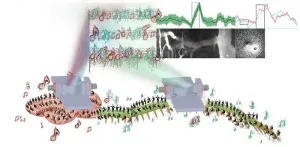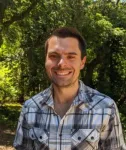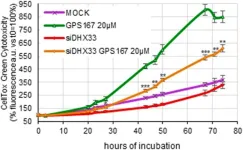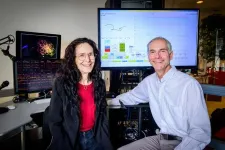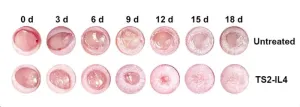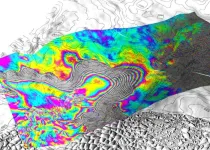(Press-News.org) Cislunar space, which stretches from the Earth to just beyond the moon’s orbit, is about to become heavily trafficked over the next 10 years. With NASA’s planned Artemis missions and other countries joining in the cislunar space race, there’s an interest in observing, tracking and predicting the orbit of objects like asteroids and satellites so they don’t collide with spacecraft.
But the process of detecting and observing space objects, known as space domain awareness (SDA), faces challenges with the extensive volume of cislunar space.
“Cislunar space is vast,” says Tarek Elgohary, an associate professor of aerospace engineering. “The current SDA infrastructure, which is mostly Earth-based, is not equipped to provide the needed coverage in cislunar space. There is a need for fast and accurate solutions to quantify uncertainties to improve predictions and provide SDA information in the absence of continuous coverage.”
Elgohary and his team will develop those solutions with the support of a $350,000 grant from the Air Force Office of Scientific Research Dynamic Data and Information Processing Program. They will create a computational framework to rapidly and accurately track space objects in real time, onboard spacecraft or satellites like the Air Force Research Laboratory’s Oracle, which is designed to increase SDA capabilities in cislunar space. The algorithms will allow Oracle and other spacecraft to operate autonomously without intervention from Earth.
Those same algorithms could also have an impact on maritime domain awareness (MDA). Just as spacecraft might need to identify space junk or track the orbit of a satellite, watercraft need to identify other vessels, predict target trajectories and detect suspicious behavior in real-time.
“Space and maritime domains share a lot of similarities in terms of the lack of continuous coverage of spacecraft or vessels, the large size of the search domain, and the need for the capability to predict maneuvers,” Elgohary says. “Maritime domain awareness may require shorter time scales; however, with the expansion of space missions, space domain awareness operations have been reduced from weeks and days to hours and minutes.”
Elgohary will use his expertise in space to develop a similar computational framework for the sea. The algorithms developed for uncertainty quantifications will advance MDA and allow sea vessels to detect objects in real time and predict their future location.
This work is funded through a $150,000 grant from Lockheed Martin.
About the Researcher
Tarek Elgohary joined UCF in 2016 as an assistant professor. He manages the Astrodynamics, Space and Robotics Laboratory (ASRL) in the Department of Mechanical and Aerospace Engineering. He earned a bachelor’s degree in mechanical engineering from the American University in Cairo and a master’s degree and doctoral degree in aerospace engineering from Texas A&M University.
Writer: Marisa Ramiccio
END
UCF researcher is developing algorithms to further space, sea exploration
The work will help protect spacecraft from colliding with objects like asteroids and satellites.
2024-05-20
ELSE PRESS RELEASES FROM THIS DATE:
Illuminating neuro-vascular dynamics throughout the body: 3D-printed implants and bioluminescence duet shed light on brain–spinal interactions
2024-05-20
A sensory process such as pain is no ordinary phenomenon—it’s a symphony of neural and vascular interactions orchestrated by the brain and spinal cord. Attempting to dissect this symphony by focusing on a single region is like trying to understand a complex melody by listening to just one instrument. It’s incomplete, potentially misleading, and may result in erroneous conclusions.
Enter the Carney Institute’s team of visionaries. Their mission? To develop tools that allow unprecedented observation of neural and vascular activity within the brain and spinal cord. They tackled two critical fronts: imaging hardware and bioluminescent (BL) molecular tools.
Innovative ...
Studies show linked biological pathways driving skin inflammation
2024-05-20
A certain biological pathway, a set of linked reactions in the body, drives the inflammation seen in the skin disease psoriasis, a new study finds. The work could lead to improved therapies for all inflammatory skin diseases, including atopic and allergic dermatitis and a type of boil called hidradenitis suppurativa, say the study authors. Inflammation is the body’s natural response to irritation and infection, but when out of control, it can lead to the reddish, flaky, itchy lesions that come with these skin diseases.
Led by researchers at NYU Langone Health, the new study found that the interleukin-17 (IL-17) pathway, ...
Fowler awarded 2023 NASA Planetary Science Early Career Award
2024-05-20
Research Assistant Professor Christopher Fowler received the NASA 2023 Planetary Science Early Career Award for his project “Bringing Planetary Science to West Virginia”. The award is based on demonstrated leadership, involvement in the planetary science community, and potential for future impact.
The resources provided by the NASA Planetary Science Early Career Award will allow Fowler and team to undertake research-related activities that are not always possible within the scope of more “traditional” ...
Anticancer potential of CLK kinase inhibitors 1C8 and GPS167 via EMT and antiviral immune response
2024-05-20
“[...] we have characterized a pair of compounds that impact multiple processes that are relevant to cancer cell proliferation but also, and possibly more importantly, to metastasis [...].”
BUFFALO, NY- May 20, 2024 – A new research paper was published in Oncotarget's Volume 15 on May 16, 2024, entitled, “The anticancer potential of the CLK kinases inhibitors 1C8 and GPS167 revealed by their impact on the epithelial-mesenchymal transition and the antiviral immune response.”
The diheteroarylamide-based compound 1C8 and the aminothiazole carboxamide-related compound GPS167 inhibit the CLK kinases, and affect ...
Aging contributes to 2024 Systems Aging Gordon Research Conference
2024-05-20
Aging is contributing at the 2024 Systems Aging Gordon Research Conference in Barcelona, Spain, from June 2–7.
BUFFALO, NY- May 20, 2024 – Aging is a contributor at the 2024 Systems Aging Gordon Research Conference (GRC) on “Systems Modeling, Aging Biomarkers, and Longevity Interventions” — taking place from June 2–7, 2024, in Castelldefels, Barcelona, Spain.
“The conference will present recent advances in systemic rejuvenation, multi-omics approaches, applications ...
Pioneering research study makes significant contributions toward addressing the shortage of suitable knee meniscus and TMJ disc replacements
2024-05-20
The shortage of suitable donor meniscus grafts from the knee and temporomandibular joint (TMJ) impedes treatments for millions of patients. Vitrification offers a promising solution by transitioning these tissues into a vitreous state at cryogenic temperatures, protecting them from ice crystal damage using high concentrations of cryoprotectant agents (CPAs). However, vitrification's success is hindered for larger tissues (>3 mL) due to challenges in CPA penetration. Dense avascular meniscus tissues require extended CPA exposure for adequate penetration; however, ...
By listening, scientists learn how a protein folds
2024-05-20
CHAMPAIGN, Ill. — By converting their data into sounds, scientists discovered how hydrogen bonds contribute to the lightning-fast gyrations that transform a string of amino acids into a functional, folded protein. Their report, in the Proceedings of the National Academy of Sciences, offers an unprecedented view of the sequence of hydrogen-bonding events that occur when a protein morphs from an unfolded to a folded state.
See video: Protein Sonification
“A protein must fold properly to become an enzyme or signaling molecule or whatever its function may be — all the many things that proteins do in our bodies,” said University of Illinois ...
Nano drug accelerates diabetic wound healing in mice
2024-05-20
New York, NY [May 20, 2024]—Researchers at the Icahn School of Medicine at Mount Sinai have designed a regenerative medicine therapy to speed up diabetic wound repair. Using tiny fat particles loaded with genetic instructions to calm down inflammation, the treatment was shown to target problem-causing cells and reduce swelling and harmful molecules in mouse models of damaged skin.
Details on their findings were published in the May 20 online issue of the Proceedings of the National Academy of Sciences (PNAS).
Diabetic wounds, often resistant to conventional treatments, ...
UC Irvine-led team uncovers ‘vigorous melting’ at Antarctica’s Thwaites Glacier
2024-05-20
Irvine, Calif., May 20, 2024 — A team of glaciologists led by researchers at the University of California, Irvine used high-resolution satellite radar data to find evidence of the intrusion of warm, high-pressure seawater many kilometers beneath the grounded ice of West Antarctica’s Thwaites Glacier.
In a study published today in Proceedings of the National Academy of Sciences, the UC Irvine-led team said that widespread contact between ocean water and the glacier – a process that is replicated throughout Antarctica and in Greenland – causes “vigorous melting” and may require a reassessment of ...
Warm seawater speeding up melting of ‘Doomsday Glacier,’ scientists warn
2024-05-20
EMBARGOED UNTIL 15:00 EDT MONDAY, MAY 20, 2024
For the first time, there is visible evidence showing that warm seawater is pumping underneath Antarctica’s Thwaites Glacier—ominously nicknamed the Doomsday Glacier.
An international team of scientists—including a researcher from the University of Waterloo—observed it using satellite imagery and warns that it could accelerate catastrophic sea level rise in 10 to 20 years.
The intrusion of seawater causes the ice to continuously lift off the land and settle back down again. Ice melts intensely when it first touches seawater, ...
LAST 30 PRESS RELEASES:
Innovative techniques enable Italy’s first imaging of individual trapped atoms
KIER successfully develops Korea-made “calibration thermoelectric module” for measuring thermoelectric device performance
Diversifying US Midwest farming for stability and resilience
Emphasizing immigrants’ deservingness shifts attitudes
Japanese eels, climate change, and river temperature
Pusan National University researchers discover faster, smarter heat treatment for lightweight magnesium metals
China’s 2024 Gastroenterology Report: marked progress in endoscopy quality and disease management
Pusan National University researchers uncover scalable method for ultrahigh-resolution quantum dot displays
Researchers use robotics to find potential new antibiotic among hundreds of metal complexes
Gut bacteria changes at the earliest stages of inflammatory bowel disease
Scientists develop new way to “listen in” on the brain’s hidden language
Brain research: “Pulse generators” grow and shrink as memories are formed
For teens, any cannabis use may have impact on emotional health, academic performance
School meals could unlock major gains for human and planetary health
Menopause hormone therapy does not appear to impact dementia risk
Signature patterns of brain activity may help predict recovery from traumatic brain injury
Dresden study uncovers new key mechanism in cancer cells
New species are now being discovered faster than ever before, study suggests
Cannabis-based products show limited short-term benefit for chronic pain, with increased risk of adverse effects
Cannabis products with more THC slightly reduce pain but cause more side effects
Clearing the brain of aging cells could aid epilepsy and reduce seizures
Brain injuries linked with potential risk of suicide, new study finds
New technique lights up where drugs go in the body, cell by cell
New study finds movement of fishing fleets can reveal shifts in marine ecosystems
Embargoed: New evidence points to potential treatment for vascular dementia
Study uncovers disrupted brain balance in alcohol dependence
Working in groups can help Republicans and Democrats agree on controversial content moderation online
Structural findings reveal how distinct GPCR ligands create different levels of activation
Anything-goes “anyons” may be at the root of surprising quantum experiments
UC review: Maximizing workplace opportunity for veterans
[Press-News.org] UCF researcher is developing algorithms to further space, sea explorationThe work will help protect spacecraft from colliding with objects like asteroids and satellites.
